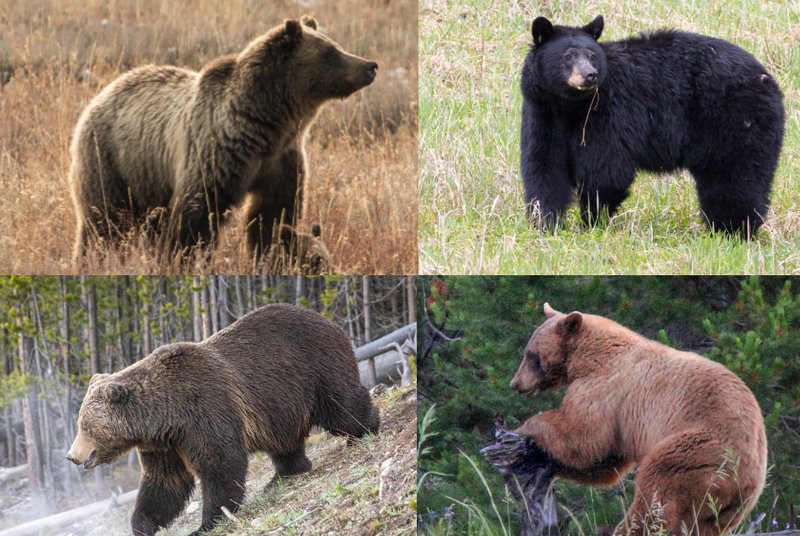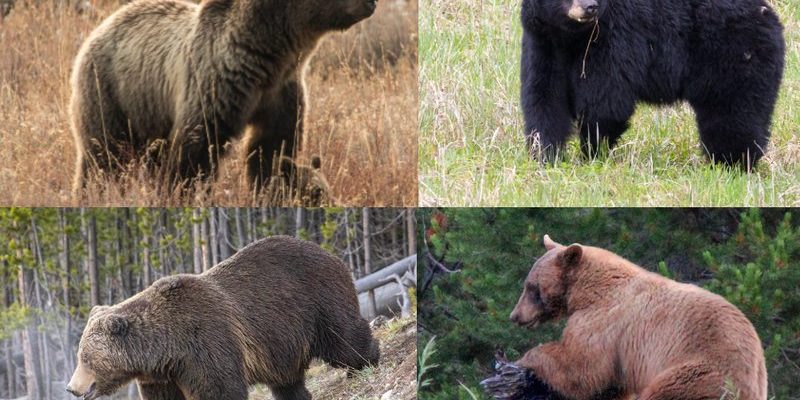
Take a moment to imagine walking through a dense forest, surrounded by the sounds of chirping birds and rustling leaves. Suddenly, you spot a dark shape moving in the distance. Is it a black bear? Or perhaps one of its cousins? Knowing the differences can mean the difference between a thrilling encounter and a potentially dangerous situation. Let’s dive in and explore ten animals that are similar to black bears, and I’ll guide you on how to tell them apart.
1. Grizzly Bears
Grizzly bears are perhaps the most well-known relatives of black bears. With their larger size and distinctive hump on their backs, identifying them isn’t too tricky if you know what to look for. Grizzlies can weigh between 400 to 1,500 pounds, which makes them significantly heavier than your average black bear.
One of the key features to note is the **coloration**. While black bears can be, well, black, grizzlies typically have a brown coat with lighter tips that gives them a frosted appearance. Additionally, their **facial profile** is different: grizzlies have a more pronounced “dished” face, and their ears are smaller and rounder compared to a black bear’s ears.
If you ever find yourself in bear country and see a bear with a pronounced hump and lighter fur, you might just be staring at a grizzly!
2. Kodiak Bears
Kodiak bears are another close relative of black bears and are among the largest bear species in the world, along with the polar bear. They primarily inhabit the Kodiak Archipelago in Alaska. While they share some similarities with grizzlies, Kodiaks tend to be even **larger** and have a broader head.
Distinguishing Kodiaks from black bears can be challenging due to their darker fur, which can sometimes appear similar to a black bear. However, their sheer **size** is the most telling feature. A Kodiak can weigh over **1,500 pounds**! If you see a bear that looks big enough to have its own zip code, it’s probably a Kodiak.
3. Asiatic Black Bears
Asiatic black bears, also known as moon bears, are another bear species that resemble black bears. These bears have a glossy black coat with a distinctive white “V” mark on their chest, setting them apart visually. They live primarily in the forests and mountains of Asia, from India to Japan.
While their appearance might resemble that of a black bear, Asiatic black bears have a slightly **longer snout** and larger ears. Plus, their smaller size—usually between 220 to 440 pounds—makes them lighter than their North American cousins. If you’re ever in Asia and spot a bear with a shiny black coat and a white chest marking, now you know what it might be!
4. Spectacled Bears
Spectacled bears are South America’s only bear species and have some striking features that make them quite unique. Their name comes from the light-colored markings around their eyes, which can resemble spectacles. They have a dark fur coat, similar to black bears, but are generally smaller in size.
These bears tend to be more shy and elusive compared to black bears, often found high in the trees or hiding in dense foliage. They usually weigh between **200 to 400 pounds**, making them less intimidating than the larger bears. If you see a bear with some unique facial markings deep in the forests of the Andes, it could very well be a spectacled bear!
5. Sloth Bears
Sloth bears are known for their shaggy fur and unique diet, consisting mainly of insects. They can be found in the forests of India and Sri Lanka and are typically black, similar to black bears. However, they have a distinct **white or cream-colored chest patch** that can help identify them.
Their **long snouts** and lack of the typical bear shape—especially when they stand on all fours—further set them apart from black bears. They’re also generally smaller, weighing around **150 to 300 pounds**. If ever you come across a bear that looks a bit out of shape with a scruffy coat, it might just be a sloth bear!
6. Sun Bears
Sun bears are the smallest bear species in the world and hail from Southeast Asia. They have a distinctive appearance with a short, sleek coat and a **tan badge** on their chest, resembling a crescent moon. Though they can occasionally be black, their overall size and design make them markedly different from black bears.
Sun bears are known for their long tongues, which help them reach honey and insects. They usually weigh between **60 to 150 pounds**, so they’re quite a bit lighter than black bears. Watching a sun bear climb a tree or search for food is a delightful sight—not something you won’t miss if you’re in their habitat.
7. Polar Bears
Polar bears are known for their striking white fur, which helps them blend in with the ice and snow of the Arctic. They are much larger than black bears, typically weighing between **900 to 1,600 pounds**. While they differ in color, polar bears share some similarities in shape, like their rounded ears and large bodies.
To distinguish a polar bear from a black bear, consider their habitat: polar bears are primarily found in icy climates, while black bears thrive in forested areas. If you’re somewhere cold and spot a massive bear with a snow-white coat, you’ve got yourself a polar bear!
8. American Black Bears
Yes, you read that right! While these bears are technically black bears, they come in various color phases, including brown and cinnamon. They are found throughout North America and are known for being more social and curious compared to their larger cousins.
To tell them apart, look for the **size and shape** of their ears. American black bears have a more rounded, compact ear shape and often display a shorter snout than other bear species. If you see a medium-sized bear with a curious look perched on a tree, there’s a good chance it’s an American black bear, even if it’s not all black!
9. Raccoons
Raccoons are not bears, but they can be mistaken for baby black bears because of their black fur and size. With their distinctive black mask and ringed tails, raccoons often inhabit urban areas, scavenging for food, which can sometimes lead to bear confusion.
Raccoons are much smaller than black bears, usually weighing between **8 to 20 pounds**. They have a more slender body and are much more agile, often climbing trees with ease. Spotting a raccoon rummaging through a garbage can in your backyard is a sure sign that it’s not a black bear!
10. Coyotes
Lastly, let’s talk about coyotes. Again, not a bear, but in certain lighting and from a distance, they might be mistaken for young black bears. Coyotes are generally about the size of a medium dog, weighing between **24 to 46 pounds**.
Their fur can range from gray to reddish-brown, and they often have pointed ears, which are quite different from the rounded ears of black bears. If you spot an animal with a bushy tail and sharp features scampering through the woods, chances are it’s a coyote and not a bear.
Final Thoughts
Exploring the world of wildlife is always an adventure. Understanding the differences between black bears and similar animals not only enriches our knowledge but can also keep us safe during outdoor excursions. Whether you’re a wildlife enthusiast or just someone curious about nature, knowing these distinctions can help ensure you enjoy your time in the great outdoors safely.
So next time you’re out hiking or camping, and you catch a glimpse of a bear—or a creature resembling one—take a moment to observe its features and behavior. You might just find that you’re witnessing an incredible array of wildlife right before your eyes!

